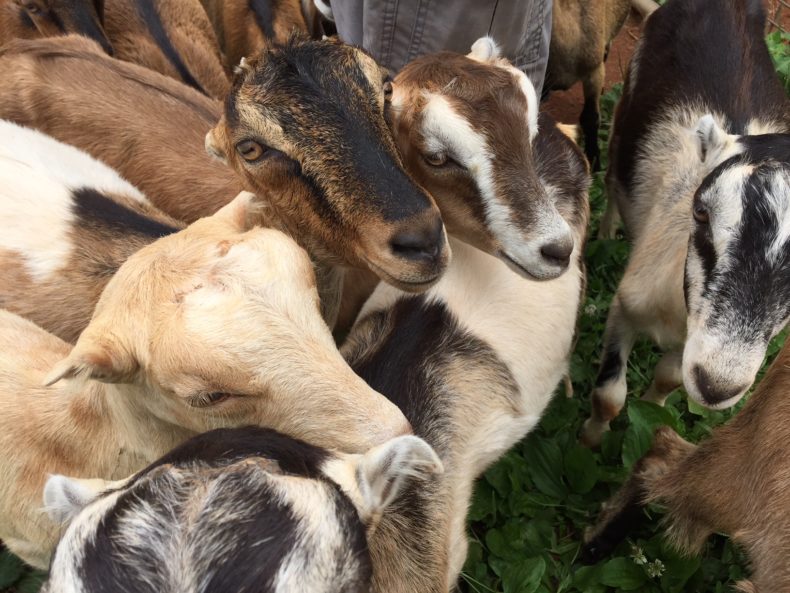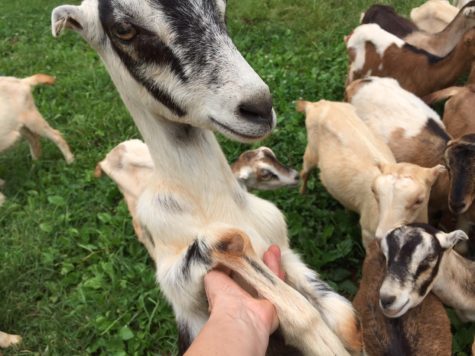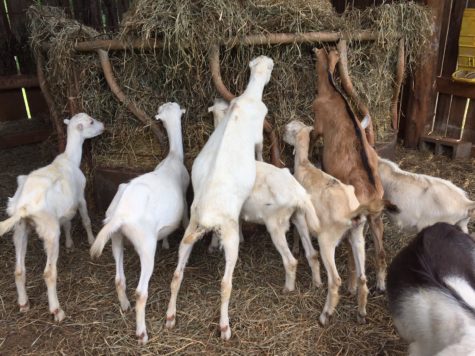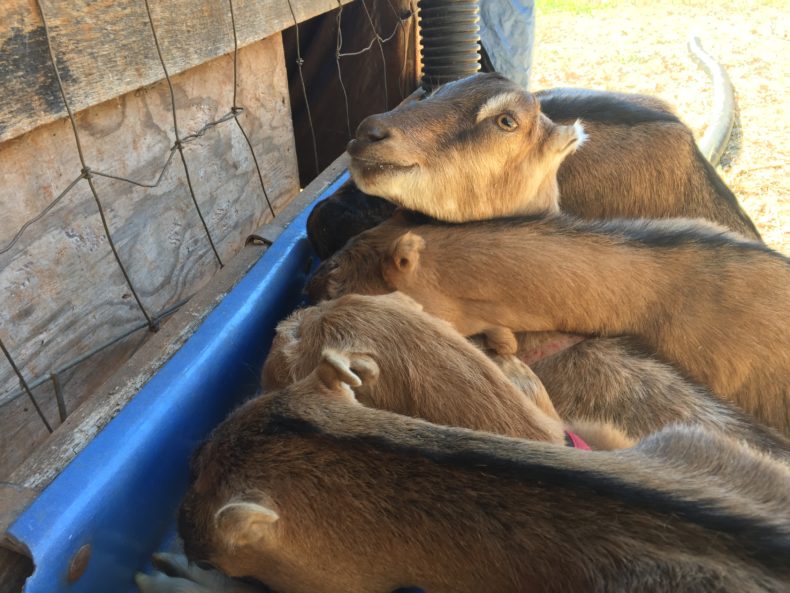 Baby, it’s cold outside! So I’m posting a little look-back at some warmer-weather fun on the farm.
Baby, it’s cold outside! So I’m posting a little look-back at some warmer-weather fun on the farm.
————–
I love goats. In many ways they’re a lot like dogs, and I love dogs. So, it follows.
How are they like dogs? At least the ones I’ve met love attention. They want to be petted and loved. They look you in the eye and make you feel needed. They’ll jump and climb on you in a friendly way. They’re not shy about whapping you with a foot if you stop stroking them. (I prefer the dog’s paw in this scenario, because cloven hoof.) They burp and poop a lot. They have terrible breath. (Fermented hay is pungent stuff.) They live about as long as dogs. They love taking walks.
I’ve learned these things because I’ve been spending some time on a farm in central Virginia that had (before a big sale in September) 100-plus goats, lots of them young females. The place is called Caromont Farm and it’s known in the area because Gail, the owner, makes fantastic (goat-milk) cheeses in a small building on the property, and she invites the public to come cuddle the kids (baby goats) each spring. She gets so many requests for the latter that she now schedules all-day cuddlefests and sells tickets for $10.
One day I wrote to her and offered to help out on the farm periodically in exchange for time with the animals. She kindly replied yes. (We know some of the same people, plus I can be really persuasive when offering to work for free.) For the first hour I’m there I’ll scrub out some feeding troughs and fill water buckets; I’ll toss down hay bales from the barn loft, break them apart, and stuff armfuls into the metal feeding baskets hanging here and there. I’ll then fork the old, poop-smeared straw from the goat beds into a wheelbarrow and dump that into an old pickup truck. (Everyone else probably already knows this, but hay is the good nutritious stuff, cut before the plant goes to seed, and straw is the leftover stem from seed or grain production.)
But that’s all just for show. What I really want to do the whole time I’m there is to play goatherd. (I’m thinking of adding The Occasional Goatherd, or TOG, to my resume.) Only recently did I learn this term, goatherd. I knew “goatherder” was correct but “goatherd” is also completely acceptable. And it saves letters, which saves time and ink, which is good.
There’s something immensely satisfying about crossing a wide grassy field and looking back to see 30-odd animals, their big trusting eyes on you, following along. They’ll rush to catch up, bleeting in that gentle way of theirs, bumping one another without aggression to get the best spot at my heels. (There’s no fighting, though. True pacifists, the female goats—also called nannies or does.) Best is when a burst of happy sends a couple of them into a sudden playful kick-up-their-hooves leap.
I take them through a pair of gates down past the stream onto the neighboring property where there’s especially good, diverse forage. At least three filthy dogs come along, tearing circles around the herd, doing their job. They’ll get distracted for a time—wrestling, splashing in the water, lying in the sun in Sphinx pose with wet tongues lolling. But they pop up and run when they’re needed, making sure their charges don’t stray too far. I don’t even have to ask.
The goats on Caromont are of three sorts: Alpines, Saanens, and Lamanchas. Alpines are French and have horns and sticky-uppy ears. Saanens are Swiss and some have tassels or wattles (also called bells or skin tabs), a pair of little fleshy things dangling from the neck that remind me of the payot (side locks) that some Orthodox Jewish men wear. [Fun fact! A general term for the wattle is caruncle, which also describes the similar anatomic features dewlaps and snoots. I wish I had a law firm so I could name it Wattle, Dewlap, and Snoot.]
The Lamanachas, a breed developed in the U.S., have pretty much no external ears. The look takes some getting used to, but now I find their nearly smooth heads quite sweet. (They often have wattles, too.)
Something else I’ve noticed as TOG is that goats grab their food with their lips, which is funny to watch. The upper jaw is wider than the lower jaw, so they can only grind the food on one side of the mouth at a time. Thus, that rotary jaw movement as they chew. (Cows have this, too.)

When Gail was away one day recently, one of her male goats (which are called bucks or billies) snuck into the pen full of young does and had a good old time. On my recent visit Gail and I stood leaning on the fence observing just how pregnant those girls now are. “What I see there is a lot of work,” she said. That round of births will happen in late January, earlier than the “normal” season that will follow, and since young mothers sometimes lose interest and walk away from their young (making the term “kidding,” for the birth process, kind of appropriate), the farm staffers have to make sure each kid gets the food and care it needs. Not all of the babies will survive their first week. It’s sad but that’s just nature doing her thing.
I’m hoping to come at some point during the kidding to assist—all night, if that’s how things go (which is likely). I expect to get gooey and bloody, but I’ll be helping to bring wee goats into the world, and that’s exciting.
On this visit, though, things were low key. So Gail and I sat down against one of the barns, right there in the dirt and straw and poop pebbles, with the sun on our faces. A few of the does came right over to cuddle with us, then more joined them, pressing their bodies close. They kept burping as I petted them, a gurgle that sounded almost like a purr, and Gail said that meant they were happy and comfortable, that they liked me. (She may have said that simply to make me feel good—burping is just something goats do a lot. Like cows, they don’t care about global warming at all.)
With two nannies half in her lap and another trying to nibble her ear, she said what I was thinking: “This is the best part. This is what it’s all about.”
——
Photos by TOG (that’s me)